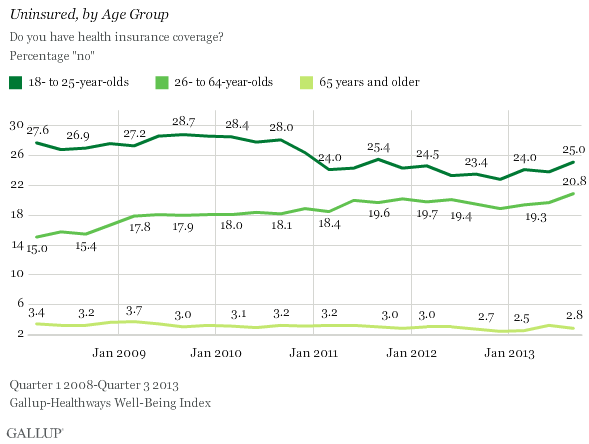WASHINGTON, D.C. -- More U.S. adults were uninsured in the third quarter of 2013 than in any quarter in nearly six years of Gallup and Heathways tracking, with 18% reporting they lacked health insurance. This represents the third consecutive quarter in which the uninsured rate has ticked up.

The uninsured rate has increased since Gallup and Healthways started monitoring U.S. adults' health insurance coverage status daily in January 2008 as part of the Gallup-Healthways Well-Being Index. The rate hovered in the 14% range in 2008, rose to the 16% range in 2009-2010, and ticked up to the 17% range for most of 2011. In 2012, the uninsured rate steadily declined each quarter, but has since increased.
These data were collected in the third quarter of 2013, before the health insurance exchanges -- which allow Americans to buy health coverage in a competitive marketplace as required by the 2010 Affordable Care Act (ACA) -- opened on Oct. 1. Thus, the estimate provides a solid baseline from which to measure changes in the uninsured population as the healthcare law is fully implemented.
One in Four Young Adults Are Uninsured
One in four young adults in the U.S. say they lack health insurance, the highest rate found since the third quarter of 2011. Still, the current percentage of 18- to 25-year-olds who lack healthcare coverage remains below the 27-28% range seen from 2008 through the third quarter of 2010, when the healthcare provision allowing those up to age 25 to stay on their parents' plans went into effect.

The uninsured rate for 26- to 64-year-olds ticked up to a new high of 20.8% in the third quarter of 2013, an increase of more than one percentage point from the second quarter. The uninsured rate for this age group has generally trended upward since 2009.
The percentage of seniors who lack health insurance declined slightly to 2.8% in the third quarter, but has generally remained stable around 3% over the years because a large majority qualify for Medicare.
Implications
The uninsured rate for U.S. adults averaged 18% in the months leading up to the opening of the health insurance exchanges that allow Americans to get health insurance as mandated by the ACA. The requirement does not go into effect until January 2014, with the government allowing a grace period through the end of March for Americans to get insurance. However, the White House is considering postponing the deadline for Americans to get insurance.
Gallup recently found that seven in 10 uninsured Americans say they are aware they need to get health insurance or pay a fine by Jan. 1, 2014, but the same percentage is unfamiliar with the insurance exchanges -- the place where the uninsured would be most likely to get coverage.
The White House says there have been approximately 20 million visits to the federal health exchange website, Healthcare.gov, in the first two and a half weeks since it went live and approximately 500,000 Americans have submitted applications for health insurance through the federal and state-run health exchange websites. However, there have been extensive technical issues plaguing the federal exchange website, which could negatively affect the number of uninsured Americans who sign up for insurance.
Still, it is likely that the rate of uninsured Americans will begin to drop in 2014 as more uninsured Americans get coverage as required under the healthcare law.
Editor's Note: The Quarter 2 data for 2013 in this article reflects a revision of -0.1 points from the original version.
About the Gallup-Healthways Well-Being Index
The Gallup-Healthways Well-Being Index tracks well-being in the U.S. and provides best-in-class solutions for a healthier world. To learn more, please visit well-beingindex.com.
Survey Methods
Results are based on telephone interviews conducted as part of the Gallup-Healthways Well-Being Index survey July 1-Sept. 30, 2013, with a random sample of 45,743 adults, aged 18 and older, living in all 50 U.S. states and the District of Columbia.
For results based on the total sample of national adults, one can say with 95% confidence that the margin of sampling error is ±0.5 percentage points.
Interviews are conducted with respondents on landline telephones and cellular phones, with interviews conducted in Spanish for respondents who are primarily Spanish-speaking. Each sample of national adults includes a minimum quota of 50% cellphone respondents and 50% landline respondents, with additional minimum quotas by region. Landline and cellphone numbers are selected using random-digit-dial methods. Landline respondents are chosen at random within each household on the basis of which member had the most recent birthday.
Samples are weighted to correct for unequal selection probability, nonresponse, and double coverage of landline and cell users in the two sampling frames. They are also weighted to match the national demographics of gender, age, race, Hispanic ethnicity, education, region, population density, and phone status (cellphone only/landline only/both, and cellphone mostly). Demographic weighting targets are based on the March 2012 Current Population Survey figures for the aged 18 and older U.S. population. Phone status targets are based on the July-December 2011 National Health Interview Survey. Population density targets are based on the 2010 census. All reported margins of sampling error include the computed design effects for weighting.
In addition to sampling error, question wording and practical difficulties in conducting surveys can introduce error or bias into the findings of public opinion polls.
For more details on Gallup's polling methodology, visit www.gallup.com.
